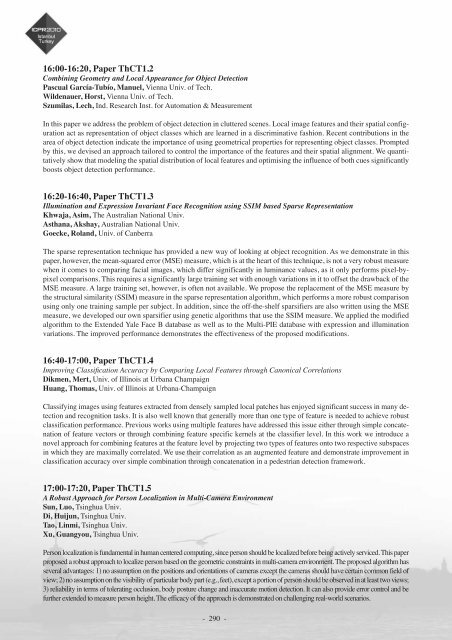Abstract book (pdf) - ICPR 2010
Abstract book (pdf) - ICPR 2010
Abstract book (pdf) - ICPR 2010
- TAGS
- abstract
- icpr
- icpr2010.org
Create successful ePaper yourself
Turn your PDF publications into a flip-book with our unique Google optimized e-Paper software.
16:00-16:20, Paper ThCT1.2<br />
Combining Geometry and Local Appearance for Object Detection<br />
Pascual García-Tubío, Manuel, Vienna Univ. of Tech.<br />
Wildenauer, Horst, Vienna Univ. of Tech.<br />
Szumilas, Lech, Ind. Research Inst. for Automation & Measurement<br />
In this paper we address the problem of object detection in cluttered scenes. Local image features and their spatial configuration<br />
act as representation of object classes which are learned in a discriminative fashion. Recent contributions in the<br />
area of object detection indicate the importance of using geometrical properties for representing object classes. Prompted<br />
by this, we devised an approach tailored to control the importance of the features and their spatial alignment. We quantitatively<br />
show that modeling the spatial distribution of local features and optimising the influence of both cues significantly<br />
boosts object detection performance.<br />
16:20-16:40, Paper ThCT1.3<br />
Illumination and Expression Invariant Face Recognition using SSIM based Sparse Representation<br />
Khwaja, Asim, The Australian National Univ.<br />
Asthana, Akshay, Australian National Univ.<br />
Goecke, Roland, Univ. of Canberra<br />
The sparse representation technique has provided a new way of looking at object recognition. As we demonstrate in this<br />
paper, however, the mean-squared error (MSE) measure, which is at the heart of this technique, is not a very robust measure<br />
when it comes to comparing facial images, which differ significantly in luminance values, as it only performs pixel-bypixel<br />
comparisons. This requires a significantly large training set with enough variations in it to offset the drawback of the<br />
MSE measure. A large training set, however, is often not available. We propose the replacement of the MSE measure by<br />
the structural similarity (SSIM) measure in the sparse representation algorithm, which performs a more robust comparison<br />
using only one training sample per subject. In addition, since the off-the-shelf sparsifiers are also written using the MSE<br />
measure, we developed our own sparsifier using genetic algorithms that use the SSIM measure. We applied the modified<br />
algorithm to the Extended Yale Face B database as well as to the Multi-PIE database with expression and illumination<br />
variations. The improved performance demonstrates the effectiveness of the proposed modifications.<br />
16:40-17:00, Paper ThCT1.4<br />
Improving Classification Accuracy by Comparing Local Features through Canonical Correlations<br />
Dikmen, Mert, Univ. of Illinois at Urbana Champaign<br />
Huang, Thomas, Univ. of Illinois at Urbana-Champaign<br />
Classifying images using features extracted from densely sampled local patches has enjoyed significant success in many detection<br />
and recognition tasks. It is also well known that generally more than one type of feature is needed to achieve robust<br />
classification performance. Previous works using multiple features have addressed this issue either through simple concatenation<br />
of feature vectors or through combining feature specific kernels at the classifier level. In this work we introduce a<br />
novel approach for combining features at the feature level by projecting two types of features onto two respective subspaces<br />
in which they are maximally correlated. We use their correlation as an augmented feature and demonstrate improvement in<br />
classification accuracy over simple combination through concatenation in a pedestrian detection framework.<br />
17:00-17:20, Paper ThCT1.5<br />
A Robust Approach for Person Localization in Multi-Camera Environment<br />
Sun, Luo, Tsinghua Univ.<br />
Di, Huijun, Tsinghua Univ.<br />
Tao, Linmi, Tsinghua Univ.<br />
Xu, Guangyou, Tsinghua Univ.<br />
Person localization is fundamental in human centered computing, since person should be localized before being actively serviced. This paper<br />
proposed a robust approach to localize person based on the geometric constraints in multi-camera environment. The proposed algorithm has<br />
several advantages: 1) no assumption on the positions and orientations of cameras except the cameras should have certain common field of<br />
view; 2) no assumption on the visibility of particular body part (e.g., feet), except a portion of person should be observed in at least two views;<br />
3) reliability in terms of tolerating occlusion, body posture change and inaccurate motion detection. It can also provide error control and be<br />
further extended to measure person height. The efficacy of the approach is demonstrated on challenging real-world scenarios.<br />
- 290 -



